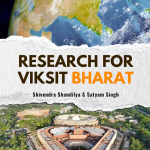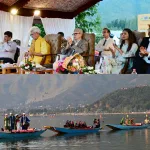The 46th Session of the World Heritage Committee was momentous for India because the event was hosted for the first time in New Delhi from 21st to 31st July 2024, thereby advocating the World Heritage Convention. The event organized by Ministry of Culture showcased our testament towards architectural grandeur and sculptural prowess. The event consisted of participation from all the Committee members and representations from the World Heritage Centre UNESCO, International Council on Monuments and Sites (ICOMOS), International Centre for the Study of the Preservation and Restoration of Cultural Property (ICCROM), International Union for Conservation of Nature (IUCN), State Parties and people from different walks of life associated with heritage management, protection, preservation and education.
This event also proved to be historic due to the inscription of the 43rd World Heritage Property of India, Moidams – the Mound-Burial system of the Ahom Dynasty, Charaideo in Assam. Before this inscription, there was no World Heritage Site under the cultural heritage category from the entire North East region. Before this inscription, only 2 (two) World Heritage Sites, Kaziranga National Park and Manas Wildlife Sanctuary – from the natural category existed in Assam. Therefore, this inscription displays the commendable partnership, management and achievement of the Directorate of Archaeology, Govt. of Assam and Archaeological Survey of India, Govt. of India who made this feat achievable.
Moidam in Charaideo, Assam
This property consists of burial mounds called ‘Moidams’ of the Ahom Dynasty. The Ahom Dynasty ruled the Brahmaputra Valley in Assam from 1228 – 1826 CE. These Moidams represent the late medieval mound-burial tradition of the Tai Ahoms in Assam which lasted 600 years until the end of the Ahom rule. These Moidams enshrine the mortal remains of Ahom royalty; the deceased with their paraphernalia were buried. The Ahoms venerate Moidams believing that one part of the deceased’s spirit has eternally resided in the Moidam that ensures the State’s well-being.
The Ahom Dynasty was established by Siu-ka-pha who established the kingdom after crossing the Patkai Mountains. The Ahom kings were given divine origin and their history recorded in Buranjis (the royal chronicle) which serve as a source of information on the political, social, cultural, military, economic history of the Ahom kingdom. After Siu-ka-pha’s death he was entombed and buried in a Moidam in Charaideo. Subsequently this tradition was continued for later rulers as well contributing to the gradual development of a royal necropolis. This royal necropolis is the latest addition to the World Heritage List of India.
The Ahom Kingdom was also displayed unwavering resilience in resisting Mughal rule, defying the vast empire’s expansion. While the Mughals dominated the Indian subcontinent, the Ahoms maintained their sovereignty, protecting their unique culture and traditions. Lachit Barphukan, a legendary Ahom general, played a pivotal role in this resistance. His strategic leadership and bravery during the Battle of Saraighat (1671) repelled the Mughal invasion, securing Ahom dominance. Barphukan’s visionary tactics and patriotic fervour inspired his people to fight for their freedom. After nearly 70 years of sustained efforts, the Mughals were ousted in the Battle of Itakhuli in 1682. The Ahoms’ successful resistance against Mughal rule serves as a testament to their strength and determination, leaving an indelible mark on India’s cultural heritage.
This year the theme of World Heritage Week 2024 is “Discover and Experience Diversity” and the goal is to promote awareness and appreciation for these unique sites. In this connection, India’s rich heritage and 43 World Heritage Properties display the perfect synergy of diversity and new experiences. Every heritage site – natural, cultural and mixed – has something to offer everybody.
From temples, forts and national parks, to burial grounds, ancient rock paintings and lasting legacies of culture, the World Heritage List of India is timeless and speaks glory of our history. After all, the heritage of a country is essentially for its cultural identity, and whether big or small, majestic or simple, physical or non-physical, it must be maintained and have a meaning for every new generation.
(The Author is Assistant Professor (History) Shaheed Bhagat Singh College; Delhi University. Feedback: [email protected])








